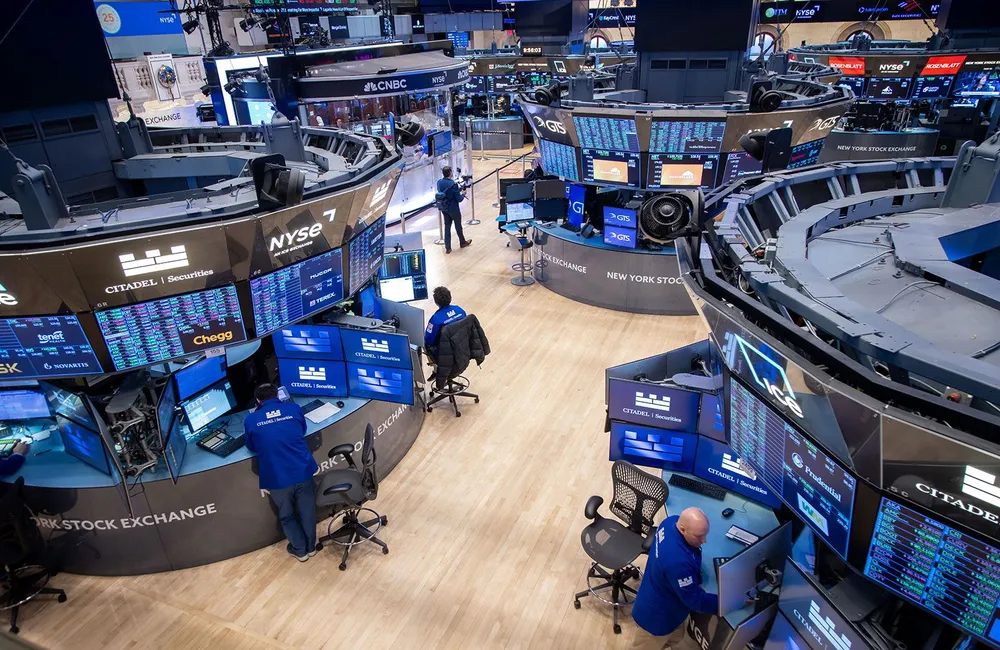ASX futures fell 26 points or 0.4% to 7186 at 8.00 am Wednesday morning, suggesting a decline at the open.
Overseas, the S&P 500 fell 0.6 percent, returning to a downward path after it ended a seven-week losing streak last week. The Dow Jones industrial average dropped 0.7%. The S&P and the Dow both finished the month nearly flat. The Nasdaq Composite fell 0.4%. The index, which is heavy on technology shares, fell 2.1% in May.
Tuesday’s session drew to a close another turbulent trading month, in which stocks around the world have swung violently as traders have tried to size up the outlook for economies worldwide. In the US, stocks plunged soon after May got under way and kept falling through a string of earnings and economic data that disappointed. New data on growth and inflation, along with better-than-expected results from major US retailers, helped global stocks trim the month’s losses.
“There’s a little bit of market uncertainty just around the pretty rapid rally that we’ve had, and the extent to which that can be sustained within a world where inflation is clearly still a factor,” said Edward Park, chief investment officer at Brooks Macdonald.
At home the S&P/ASX 200 finished 1.0% lower at 7211.1, retreating from its recent run as losses were broad based.
Financial and tech stocks were among the biggest drags as the benchmark index retreated after rising 2.5% over the previous two sessions. All 11 sectors fell.
Banks Westpac, NAB, Commonwealth and ANZ lost between 1.45% and 2.8% after the head of Australia's prudential regulator warned some mortgage borrowers would be under stress from higher interest rates.
Insurers QBE, IAG and Suncorp slid between 2.3% and 6.35% after wild winds damaged property across Australia's southeast. The tech sector shed 1.9%.
AGL Energy gained 0.5%, steadying after Monday's 1.7% drop on the scrapping of its demerger plans.
In commodities, Brent crude oil up 1.0% to US$122.84 per barrel (continuing to rally as Eurozone bans Russian oil). Iron ore was down US10 cents at US$136.50. Gold was 0.5% weaker at US$1839.50.
Local bond markets fell sharply, with the yield on Australian 2 Year government bonds jumping to 2.43%, with the 10 Year rising to 3.35%. The 2 year US Treasury notes yield climbed to 2.55%, and the US Treasury 10 year notes yield went up to 2.84% as trading resumed after the Memorial Day holiday.
The Australian dollar was at 71.76 US cents at 7.00 US cents, down from the previous close of 71.94 US cents. The Wall Street Journal Dollar Index, which measures the U.S. dollar against 16 other currencies climbed to 94.47.
Asia
Chinese shares finished higher on the session after Shanghai officials announced today that the city would enter a new stage on June 1 of comprehensive reopening. The benchmark Shanghai Composite Index gained 1.2% to end at 3186.43, while the Shenzhen Composite Index increased 1.6% to 2006.95. The startup-heavy ChiNext Price Index was the big winner of the day, closing up 2.3% on 2405.08. The market opened flat and tracked lower in the early morning, before turning positive ahead of noon after news that Shanghai would further resume production and activities. Gains were led by electronics, consumer-goods, renewable-energy and home-appliance sectors.
Hong Kong stocks closed higher, tracking gains in the Chinese market as investors welcomed Shanghai officials’ plans to further reopen the city from a monthslong lockdown. The benchmark Hang Seng Index rose 1.4% to close at 21415.20, cementing the index’s gains in May at 1.5%. The market flipped into positive territory just prior to noon after China’s state media outlets reported that Shanghai will enter a new phase of comprehensive reopening starting June 1. Consumer-goods sectors outperformed. Haidilao soared 6.3%, Meituan gained 6.8% and Li Ning was up 4.7%.
Japanese stocks fell, weighed down by declines in real-estate stocks as recent climbs in crude-oil prices revive worries about higher costs for fuel and borrowing. Sumitomo Realty & Development fell 3.7% and Daiwa House Industry shed 2.9%. Inpex, another oil explorer, surged 6.2%. The Nikkei Stock Average slid 0.3% to 27279.80.
Europe
European markets mostly declined after record eurozone inflation figures and a weaker start for Wall Street trading. The pan-European Stoxx Europe 600 fell 0.5 percent, while the French CAC 40 and German DAX lost more than 1 percent.
Inflation in the eurozone reached 8.1 percent in the year ended in May, the highest since records began in 1997. Surging prices for energy and food drove the increase, as disruptions from the conflict between Russia and Ukraine continued to roil commodity markets.
“The data from Germany and Spain made the risks heavily skewed to the upside and that’s how it played out,” writes Oanda analyst Craig Erlam. “Yields are up across the euro area again as investors price in, with the greater weight, a more aggressive pace of tightening.”
The FTSE 100 in London edged down 0.1 percent on Tuesday, as a fall in convenience retailer B&M sent a ripple and oil majors gave up ground late in the session. B&M was the blue-chip index’s biggest faller on Tuesday, with shares down 15% after it reported results for the year to 26 March. B&M is at the same time being robbed of the tailwind it had during the pandemic when its shops stayed open, while its value-based proposition means margins are skinny and open to being crushed by inflation, AJ Bell’s Russ Mould says in a note.
North America
U.S. stocks dropped on Tuesday, closing the month on a somber tone following last week’s rally.
The S&P 500 dropped 0.6 percent, continuing a slide after breaking a seven-week losing streak last week. The Dow Jones industrial average declined 0.7%. The S&P and the Dow were flat effectively for October. The Nasdaq Composite fell 0.4%. The tech-heavy index lost 2.1% in May.
Tuesday’s session capped another wild month of trading, in which stocks worldwide swung violently as investors attempted to gauge the outlook for global economies. On Wall Street, stocks fell sharply in early May, then kept dropping as a flood of earnings and economic data that came in below expectations.
Over the course of the month, a series of profit warnings from companies from Snap to Target to Walmart amplified fears about the long-dormant impact of inflation, and have driven investors to liquidate shares across multiple sectors.
By mid-May, it appeared the S&P 500 was on a path to closing in bear market territory, defined as a decline of 20 percent or more from a recent high, before a late–month rally lifted stocks. The S&P 500 closed the month 14 percent lower than its high in January.
Both professional and individual investors waded into last week’s rally in the US markets, seizing on opportunities to scoop up stocks whose valuations have dropped. Still, the fundamental issues that pummeled stocks earlier in October have not gone away.
Many traders are still concerned that the Federal Reserve’s plans to aggressively raise interest rates could push the economy into a recession. At the same time, worries over an economic slowdown in China and continued supply-chain disruptions stemming from the pandemic and the war in Ukraine have remained top of mind for investors.
“The market’s uncertainty a little bit around that relatively rapid rally we’ve had, and whether that can be sustained in a world where it’s clear inflation is still a factor,” said Edward Park, chief investment officer at Brooks Macdonald.
Some new survey data released Tuesday showed US consumer confidence crept down a tick in May from earlier months.
Crude prices surged after European Union leaders said they would impose an embargo on oil in Russia for its invasion of Ukraine, but lost some their gains later. Front-month futures for Brent crude, the global benchmark, climbed 1% to $122.84 a barrel, their highest settle since March. West Texas Intermediate, the US marker, declined 0.3% to $114.67 a barrel.
The EU sanctions would also include a ban on insuring ships that transport oil from Russia, according to The Wall Street Journal. They would include an exemption for oil delivered from Russia through pipelines, which account for one-third of EU oil purchases from Russia. At the same time, some members of OPEC are exploring a rewrite of an oil-production agreement that would exempt Russia, which could enable the rest of the organization to increase output, the Journal reported.
Shares of Unilever traded in New York rose $4.35, or 9.9%, to $48.33 after the consumer-goods company said it would add the activist investor Nelson Peltz to its board and made public that his fund now has a 1.5% stake.
The energy sector of the S&P 500 ended May with its biggest gain of the 11 groups in the benchmark index, extending a trend that had thrived most of 2022. Some of the beaten-down stocks finished the month higher, including Netflix, Robinhood Markets and Zoom Video Communications, as investors scoured for bargains that had become hard to resist in the selloff.
“When the S&P 500 is [about to cross] into a bear market, that has a very powerful psychological impact on value seekers,” said Craig Erlam, senior market analyst at Oanda. “The question being asked over and over again is, ‘Are we seeing a bottom in the markets?’"
In the bond market, the yield on 10-year Treasury notes increased to 2.842% from 2.748% on Friday. Bond yields go in the opposite direction of prices.





















